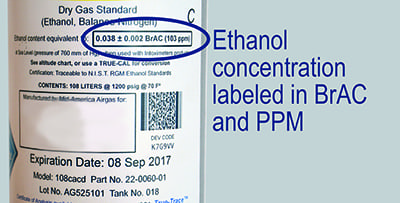Ethanol Gas Calibration Standards for Breath Alcohol Testing Devices: Making the Complex, Easier
One of the first questions asked when disputing a positive breath alcohol test is “How do you know the breath alcohol testing device was reading accurately?” The answer should be easy: “Here’s a copy of the Calibration Log for the instrument that shows all the accuracy checks and calibration adjustments performed on this instrument.”
In addition to the documented accuracy checks and calibration adjustments, understanding the calibration standard used to perform the accuracy check is critical to supporting the evidential accuracy of test results.
What is an Ethanol Gas Standard?
An ethanol gas standard is a compressed gas mixture that contains a precise amount of ethanol gas and nitrogen. Ethanol gas standards go by a variety of names: dry gas, gas tanks, alcohol gas tanks, and gas canister, to name a few. We’ll use the name convention of “ethanol gas standards” to be as clear as possible.
What’s on the Label?
An ethanol gas standard is labeled with the BrAC level of the tank as well as the margin of error allowed by the manufacturer of the gas, e.g., 0.038 +/- 0.002 BrAC. For every practical purpose the operator disregards the margin of error and uses only the stated value of the tank. In other words, the operator does not add or subtract the margin of error from the results of an accuracy check.
Evidential Quality = N.I.S.T. Traceability
A calibration standard that is “N.I.S.T. traceable” has the highest level of evidential quality.
“N.I.S.T. traceable” means that the manufacturer of an ethanol gas standard can document the specific N.I.S.T. reference standards used in the manufacture of each gas tank. (N.I.S.T. stands for National Institute of Standards and Technology, which is the agency in the U.S. that keeps the “gold standard” for all types of measurements.)
Adjusting for Effects of Barometric Pressure
Day to day fluctuations in barometric pressure caused by weather systems may cause the ethanol vapor of gas standards to change relatively insignificantly by approximately 2 -3%.
However, using an ethanol gas standard at elevations other than sea level can cause the expected results from ethanol gas standards to change by 20% or more from the BrAC on the label. As elevation increases, barometric pressure decreases; as barometric pressure decreases, the expected ethanol vapor of gas standards also decreases. For example, when used at an elevation of 5,250 ft., a tank labeled as .038 BrAC will give an ethanol vapor of .031 BrAC.
The operator corrects for the effects of barometric pressure by referring to an altitude chart usually found on the back of the tank. Elevation charts give a correction factor for each elevation range, which the operator uses to calculate the expected BrAC value.
Conclusion
The calibration standard is the linchpin of maintaining and documenting that an agency’s breath testing devices are maintained with evidential accuracy. An understanding of the ethanol gas standards will give the highest level of assurance that a program can successfully defend their breath alcohol test results.

